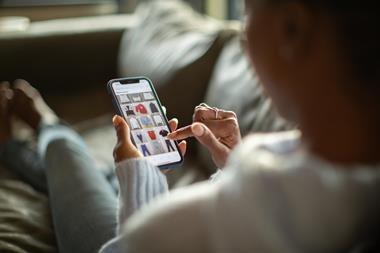Retailers are constantly looking for new ways to reach consumers, gain loyal customers and boost sales.
The rise in online shopping means retailers have to get creative at targeting shoppers, and many are doing this through shoppable ads on social media or online articles. Now shoppable ads are also gaining traction on television.

Different from the likes of shopping channel QVC, shoppable TV ads allow users with a connected TV to click on an advert and purchase directly from the screen.
In LG Ad Solutions 2023 Shoppable TV report, LG found that 81% of connected TV users in the US are influenced by television ads in their shopping decisions, and 30% said they had purchased a product directly from the TV in the past three months.
“ITV launched shoppable TV ads in 2021 enabling Love Island viewers to buy products from Boots directly on the big screen”
This new type of consumer behaviour is catching on in the UK as well. Amazon Ads recently unveiled an expanded range of new shoppable ad formats for Prime video, while UK broadcaster ITV launched shoppable TV ads in 2021 enabling Love Island viewers to buy products from Boots directly on the big screen.
Mike Shaw, director of international ad sales at streaming and smart TV company Roku, says television has always been “amazingly powerful” for retailers wishing to reach audiences on a large scale, but the shift from linear TV to online streaming has changed advertising irrevocably.
“You can now reach audiences through the remote and make the TV a shoppable unit. Money [retailers] have been investing in Google and Meta – some of that money can come back to TV, which has always performed brilliantly for brand building,’ Shaw says.
“It allows people to get further down the purchase funnel on their television than technology allowed beforehand.”
New shopping experiences
According to Statista, 74% of households reported owning a connected TV in 2023, while a survey by Advanced Television found that smart TV ad spend is set to reach £2bn in the UK by 2025.
Retailers should look to cash in on the growing trend as customer intelligence company Acxiom’s senior consultant for data strategy, Abi Acland, says there are “clear benefits” for both the retailer and the consumer.
“For the consumer, shoppable ad formats offer new shopping experiences and convenience in purchase, while for retailers they offer a new channel for e-commerce sales, a streamlined purchase journey, and effective marketing attribution – which is especially important at the moment as brands look for new ways to close the loop between views and conversions.”
Shaw echoes this, giving an example of how Roku’s first-party registration data and payment methods of logged-in users make a transaction “seamless”.
“We worked with (online food delivery service) DoorDash and found there’s a natural link between people having a movie night and wanting to order a takeaway,” he says.
“By having the integration of our payment systems within the platform, people were able to use their remote control, click OK on the DoorDash advert, order their food, and Roku already knows the payment details and address.”
Retail media opportunities
Retailers don’t have to go down the route of advertising on connected TVs – they can be the media owners instead.
Claude Spasevski, senior vice president of retail media and data at advertising tech company Equativ, said he is seeing growing interest in advertising through connected TV from retailers.
“Retail media-connected TV ad spending is set to double from 2024 to 2028. This shift is driven by retail media expanding beyond traditional digital formats and into more multimedia channels, including TV.

“Retailers are increasingly leveraging first-party data to power targeted campaigns across all devices, including TV.”
Currys has been in the retail media game since December and has recently partnered with technology company Titan OS to bring connected TV advertising for third-party brands.
The retailer said viewers will be “intelligently targeted with brand-safe, premium ad formats”, using viewing data and consent driven data from Currys for a more personalised experience.
Though Currys has not yet unveiled this as a direct shoppable format, Kate Hopkinson, media director at commerce marketing agency SMG, said she believes shoppable TV ads are the future of retail media.
“Shoppable TV ads within retail media have proven effective in driving strong results across the entire marketing funnel when strategy, planning, and audience segmentation are executed well.
“When planned correctly, they have the potential to influence consideration and even conversion metrics.”
However, she warns that retailers need to think about whether retail media is suitable for them as users buying through connected TV tend towards impulse purchases only.
Future adoption
While consumer adoption of smart TVs becomes more widespread, it’s still early days for shoppable TV ads.
LG Ad Solutions reported that only 29% of people purchased a product through a connected TV after seeing it advertised compared with 56% who purchased a product on a phone, 45% on a laptop, and 31% in-store. This isn’t to say shoppable TV can’t climb the ranks.
Spasevski says this way of advertising creates seamless integration, first-party data capture and enhanced measurement on metrics such as return on ad spend, click-through rates and sales uplift. He does, however, note its dependency on smart technology and investment.
“Not all consumers have access to smart TV’s or are comfortable making purchases this way,” he says.
“Creating a seamless and effective shoppable TV ad experience requires significant investment in technology and a creative strategy; it will not be industrialised until AI is deployed across this value chain to support widespread adoption.”


























No comments yet